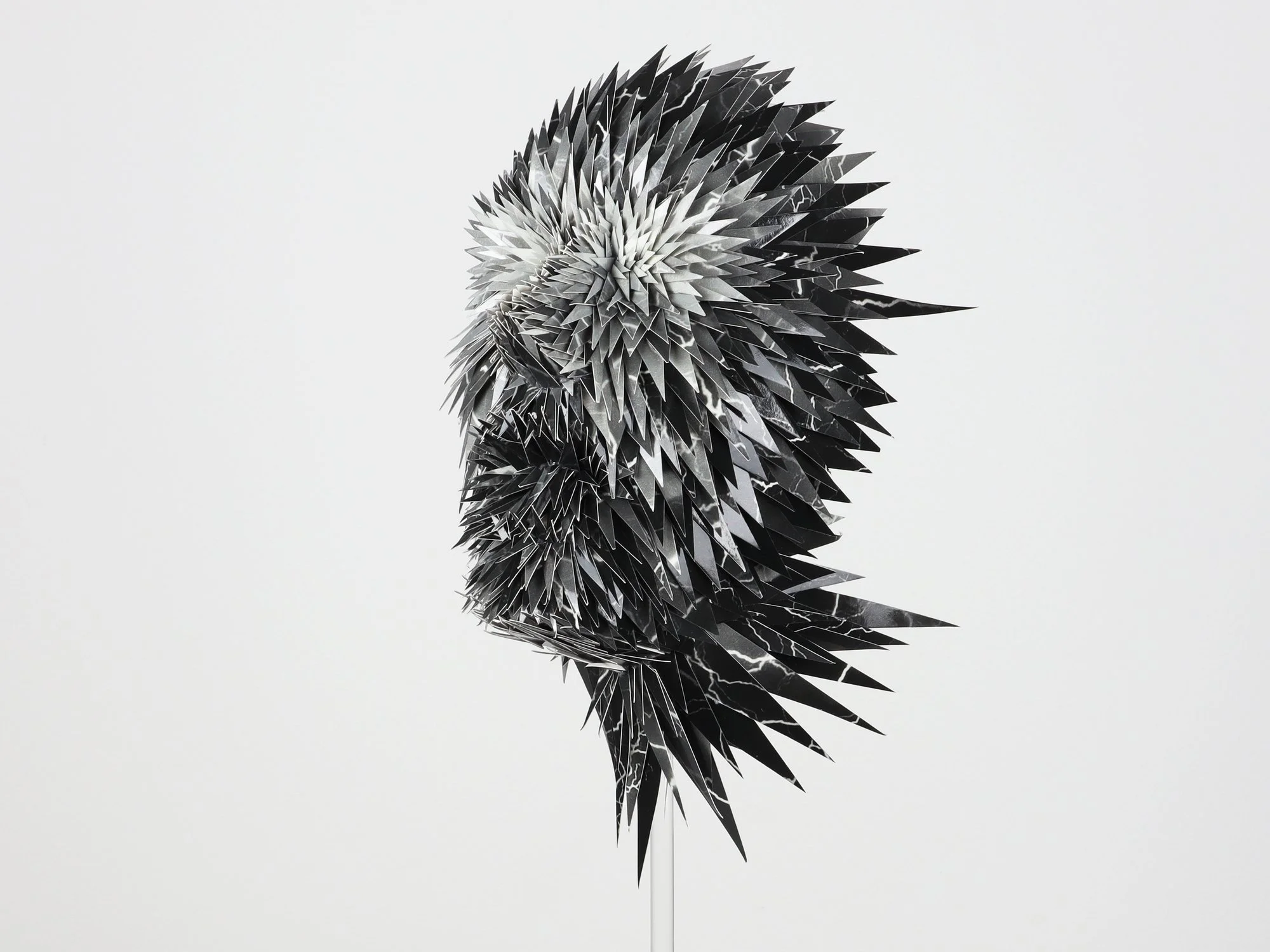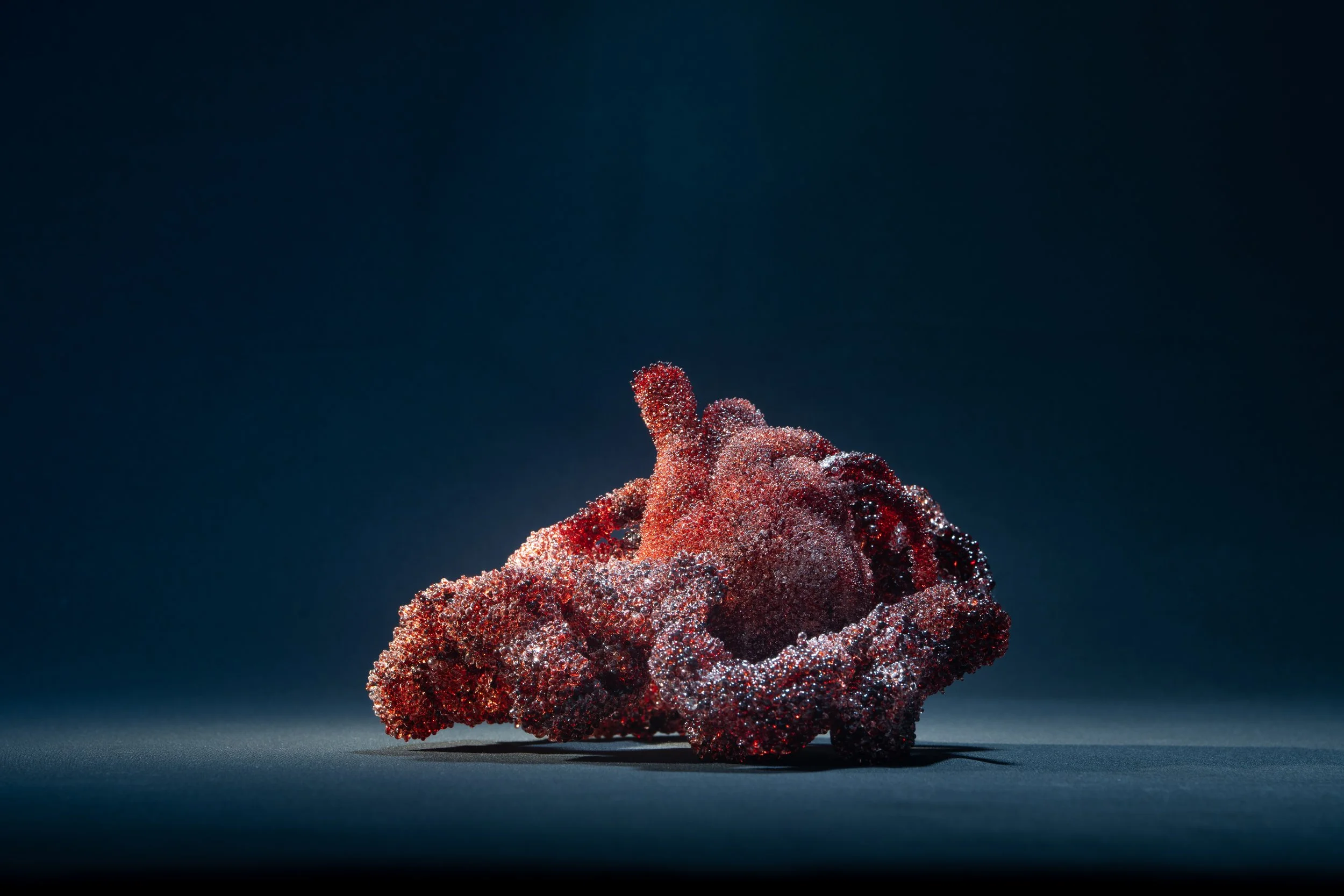INTERVIEW | Beatrice Spadea
10 Questions with Beatrice Spadea
THE ORIGINAL ISSUE10 ART MAGAZINE | FEATURED ARTIST
Beatrice Spadea (b. 1995, Monza) is a visual artist based in Italy, who graduated from the Accademia di Belle Arti di Brera, in Milan. She is currently working in her studio near Milan, and she is represented in England by JC Gallery in Mayfair, London.
In 2021 she was selected as a finalist artist for the 15th edition of the Arte Laguna Prize. One of her works, selected by the jury, has been exhibited at the finalists' exhibitions at the Arsenale of Venice. In London at JC Gallery Mayfair, Beatrice Spadea had her first solo show, "One Step Closer to the Sky."
Beatrice Spadea - Portrait
ARTIST STATEMENT
With her sensibility, the artist plays with the power of images to evoke surreal scenarios. Beatrice's work breaks through space and reveals an imaginative world that brings us beyond the heaviness of reality. Using simple materials such as paper, aluminum, and cotton threads, the artist borrows images from the natural world and reworks them according to her personal vision. Sometimes the paper is used as a metaphor for a torn body. Other times the aluminum acts as a mirror through which we see a sky in a room, joining the observer into a journey across the power of images.
A Spark in the Dark, Epoxy resin and paper covered with printed film, 8x8x14 in, 2021 © Beatrice Spadea
Masks | PROJECT DESCRIPTION
At the beginning of 2022, Beatrice has created her first NFT collection of "Masks."
The theme of the Mask had already been explored in Beatrice’s past production, but now the project has evolved to reach a new dimension for the digital world. Borrowing from the African culture, in which masks used during sacred rituals allowed to communicate with the otherworld, the Masks of Beatrice Spadea are conceived as portals that enable access to parallel universes. Every Mask is a perfect metaphor for the dematerialization and transition into the digital environment.
INTERVIEW
First of all, tell us a bit about your background and studies. What kind of education or training helped you develop your approach to art?
I've always been involved in art since a young age and went to Arts School.
Afterward, I graduated from the Accademia di Belle Arti di Brera in Milan, and - even if I have never felt completely at ease in the Academic environment - I think it considerably marked my artistic development. During those years, I have focused a lot on a key philosophical issue: why to make art and how to convey my ideas.
After Accademia, I spent one year in the studio of a well-known artist in Milan, where I could experience how to manage a studio, how to produce digital content, and how to handle communication with both collectors and gallerists. After practicing with such dynamics and acquiring new skills, I felt ready to start working for myself, and that was the moment when I decided to start working in my own studio.
You are a versatile multidisciplinary artist, but what is your preferred medium of choice, the one you will always come back to?
I don't think I have a favorite medium because the idea usually comes first in my practice, and then I decide how to give it a final shape. The process is rarely inverted. I do not mean that the medium is not important. On the contrary, I find it extremely relevant, but only at the service of the idea. As such, I find myself experimenting every time with new materials and techniques, looking for the best match with what I intend to create.
For example, last year, I have developed some ideas around the theme of parallel worlds, with the image of the sky as the focal point. I started using threads to convey these sensations of volatility, inconsistency, and fleetingness. I immediately felt connected to this material and the type of sculptures I was able to create with it, as they gave me the opportunity to explore the theme I wanted to elaborate on effectively.
This is the reason why my works are formally so different from each other, but at the same time very much connected by an underlying theme.
Making of the Masks series © Beatrice Spadea
What is your aim as an artist? What would you like the public to get away from your work?
I would like the public to access my own world and vision through a figurative narration based on a strong communicative power present in all my works.
Every work has its own story and, together with the others, acts in chorally conveying my ideas to the public. I conceive my artworks as instruments that will let me bring them with me on a journey.
In your latest project, Masks, you reference African culture and state that your masks are "conceived as portals that enable access to parallel universes. Every Mask is a perfect metaphor for the dematerialization and transition into the digital environment". How did you come up with this idea? And how did you translate it into practice?
When I started the Masks' project in 2014, I immediately realized that what I was creating had brought multiple distant influences. The theme I was dealing with was both formally and conceptually close to the African masks that I had already seen in the past, reworked by different artists.
In African tradition, the mask is worn by the shaman to connect with the otherworldly. Wearing the mask, the shaman abandoned his identity to assume what it represented, becoming a sort of medium and acting as an intermediary between the earthly world and another dimension.
After conceiving the idea, I immediately started looking for materials to use as fragments to create these masks. The latest masks I have created, like Lost in the Blue and A Spark in the Dark, are composed of small fragments that represent the sky in different atmospheric conditions. If wearing a mask means to abandon your identity, to assume the one that the mask represents, this series of masks is an invitation to look up and become that sky, to see things from above, from another perspective.
Lost in the Blue, Epoxy resin and paper covered with printed film, 8x8x14 in, 2021 © Beatrice Spadea
The Masks were originally conceived as a sculpture series in epoxy resin and paper, but you recently added an NFTs series to the sculpture production. What do those NFTs represent for you? And how do they relate to the sculptures?
I believe that the mask project integrates perfectly in the digital art environment because every mask is like a bridge that brings us beyond, to explore new worlds. They are symbolically a key to access other worlds, and we are on the verge of historical changes with the NFTs' technology that have practically unlocked access for artists to a completely new dimension to explore.
I am truly fascinated by the spiritual connotation of African masks and the idea that we can be symbolically transported to another dimension or connect with it by wearing a mask. The mask is the perfect gateway between two realities: between our tangible world and the unexplored and intangible one, that is, in this case, the digital world.
I believe that the digital development of the mask project is natural and closely bound to the sculptural one, in fact completing it. The NFT Mask is now dematerialized, but keeps its function and the underlying concept unchanged.
Physical and digital arise from the same idea. They are only conveyed in different forms so that they can speak different languages and to different interlocutors.
Above The Horizon 3/3, Epoxy resin and paper covered with printed film, 8x8x14 in, 2021 © Beatrice Spadea
Above The Horizon 2/3, Epoxy resin and paper covered with printed film, 8x8x14 in, 2021 © Beatrice Spadea
NFTs are very popular at the moment, and many artists are approaching this new trend. Why did you choose to work with NFTs? And how do you incorporate them into your production?
First of all, I am generally just truly curious about new things, and I am always inclined to experiment.
I honestly think NFTs are not just a trend, but they are charting the path of what awaits us in the future. Digital art is just the "natural" development of what we have created over the years. The fact that digital artworks can become uniquely identified assets thanks to blockchain has simply unleashed an immense world of previously limited opportunities. Apart from that, I consider NFTs a tool, while the value clearly remains within the art beyond the medium.
When I look at my entire artistic production, I see a common line. From my old works, I notice that they all express a great desire to escape, travel elsewhere, and explore new things and new worlds. The reference to the sky is always present, and it seems to be a clear invitation to escape from the reality we are used to inhabit.
When I first started hearing about NFTs, the dematerialization of art, particularly the Metaverse, I was immediately thrilled. The desire to escape and explore new worlds, which has guided all my works, would find new life if it could further evolve into digital form. I thought it would have been the perfect continuation of artistic research that, from the real world, finally lands in a new dimension. I never felt I had to force my artistic research to adapt to the digital world; I think it was born to arrive there, it's all very natural.
Let's talk about the art market and your collectors' base. You are represented by a gallery in London, what do you think of the art market? And how do you keep your collectors engaged in your latest projects?
From the beginning of 2021, I am represented by JC Gallery Mayfair. The gallerists' support has changed my approach with collectors because, as an intermediary, they now deal with them. Thanks to the gallery and, in particular to James and Cassandra, my artworks have reached a new audience and have crossed national borders, also landing in prestigious private collections in the USA. The gallerists' support has been critical to my development, and I am so lucky to have built such a strong relationship with them.
Concerning the physical masks sculptures, all the pieces that are still available for purchase are currently at JC Gallery in London, Mayfair.
Above The Horizon 1/3, Epoxy resin and paper covered with printed film, 8x8x14 in, 2021 © Beatrice Spadea
What about the future? What are you working on now and what are your plans for this year? Do you have any new projects coming up?
At the moment, I am totally involved in the launch of my first NFT collection. In parallel, I am working on a new series of sculptural works, closely recalling the theme of parallel universes and gateways. I hope to be able to present them this summer, with an exhibition.
What do you hope to accomplish in 2022, both in terms of career goals and personal life?
As an artist, personal and working life are so closely linked that it is difficult to distinguish.
In 2022, I will be focused on the development of the Mask NFT project, but at the same time, I intend to continue with my artistic research and make sure that my works can reach different types of audiences. Therefore, in 2022, I would like to expand my network abroad, looking for new growth and contamination opportunities.

























